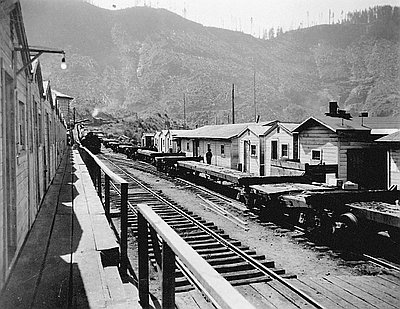In 1850, Congress passed the Donation Land Claim Act, which granted 320 acres of land to white male settlers in Oregon who were U.S. citizens. Married couples could claim 640 acres—a square mile. The rich Willamette Valley lands were settled quickly, so some latecomers traveled to the narrower valleys of the Coast Range in search of promising farmland. The earliest homesteaders came to the Alsea Valley on the central coast in the mid- to late 1850s. As in the Willamette Valley, the earliest comers got the richest bottomland. This settlement pattern was repeated on all of Oregon’s narrow coastal rivers, where good farmland was at a premium.
The Coast Range, like that of nearly all landscapes in the West, has been shaped by recurring fire over many millennia. The thick, moist coniferous forests experience fire infrequently, perhaps every two hundred to four hundred years, but when fire does come it tends to burn the forest to the ground. During the nineteenth century, several major forest fires occurred in the central Coast Range, clearing some of the heavily wooded drainages of the Alsea Basin.
The fires left the landscape that led settlers to believe it was better farmland than it actually was. The rapid regrowth of brush and trees made it exceedingly difficult to bring the land under cultivation, as the homestead laws required. Settlers were constantly cutting or burning saplings and sprouts, in addition to building houses, barns, and fences; tending livestock; and feeding and clothing families.
Along the Alsea, some people ran hogs, sheep, goats, and cattle in the hillsides, cursing the young trees and shrubs that kept springing up on their arduously cleared pastures. Enduring long hours of astonishingly difficult work, isolated from neighbors by steep, muddy trails and miserable winter weather, the Alsea homesteaders lived hard lives. “It must have been a very lonesome winter for mother,” wrote the daughter of an early settler. “The nearest neighbor woman lived eight or nine miles away over...trails, but she came to visit us, and her boys and girls came to see us quite often.”
Within a few decades many of these farms had good-sized Douglas-firs and alders growing on them. In the 1930s, landowners were given the opportunity to sell their land back to the government under a New Deal plan called the Submarginal Land Program—its very name implying what most Alsea Basin homesteaders had learned the hard way.
© Gail Wells, 2006. Updated and revised by OHP staff, 2014.







